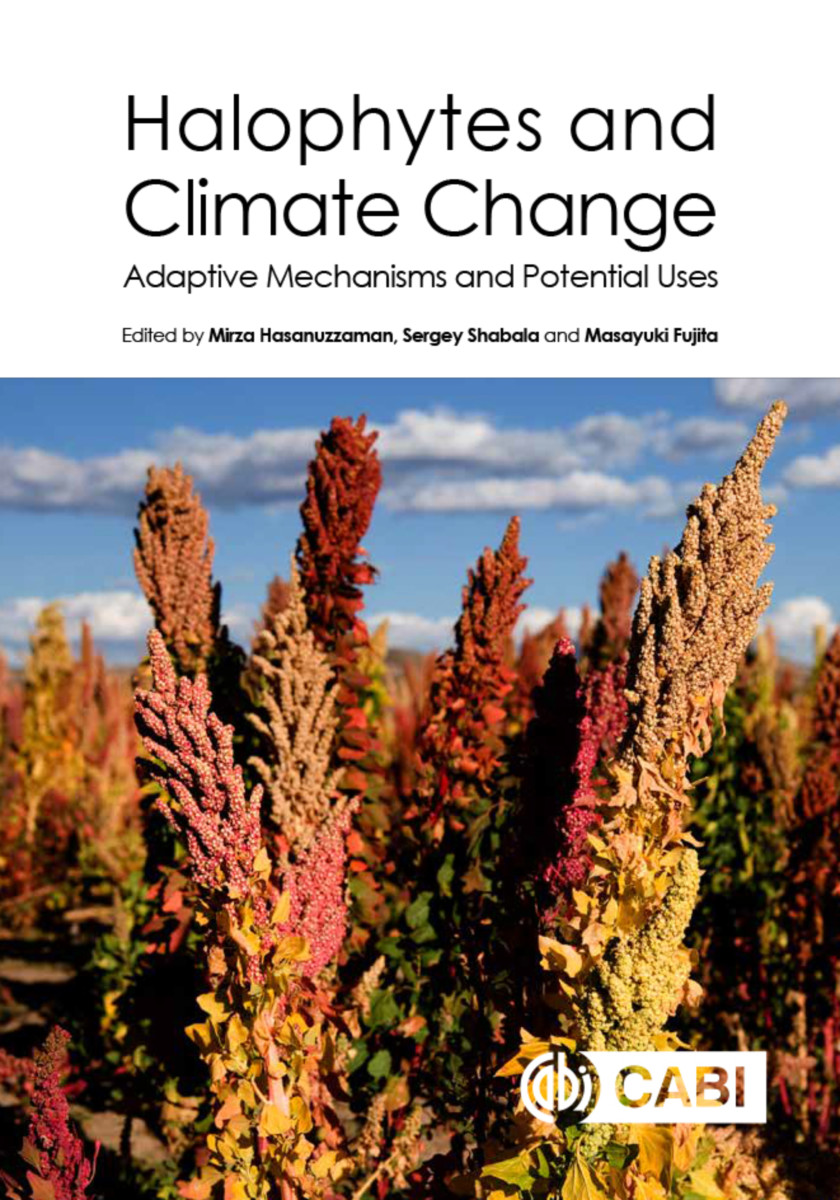Halophytes and Climate Change
Adaptive Mechanisms and Potential Uses
- Publisher
CABI - Published
8th April 2019 - ISBN 9781786394330
- Language English
- Pages 408 pp.
- Size 6.75" x 9.6"
- Images color illus
This book contains current knowledge and the most recent developments in the field of halophyte biology, ecology, and potential uses. Halophytes are characterized as plants that can survive and complete their life cycle in highly saline environments. This book explores the adaptive mechanisms and special features of halophytes that allow them to grow in environments that are unsuitable for conventional crops and considers their role as a source of food, fuel, fodder, fiber, essential oils, and medicines.
Halophytes and Climate Change includes coverage of:
- Special morphological, anatomical, and physiological features of halophytes
- Ion accumulation patterns and homeostasis in halophytes
- Potential use of halophytes in the remediation of saline soil
- Growth and physiological response and tolerance to toxicity and drought
- Mangrove ecology, physiology, and adaptation
Written by a team of international authors and presented in full color, this book is an essential resource for researchers in the fields of plant physiology, ecology, soil science, environmental science, botany, and agriculture.
List of Contributors
Preface
Section I: Ecophysiology
1: Defining Halophytes: a Conceptual and Historical Approach in an Ecological Frame
2: Habitats of Halophytes
3: Intra-habitat Variability of Halophytic Flora of North-west India
4: Halophytic Vegetation in South-east Europe: Classification, Conservation and Ecogeographical Patterns
5: South African Salt Marshes: Ecophysiology and Ecology in the Context of Climate Change
6: Seagrasses, the Unique Adaptation of Angiosperms to the Marine Environment: Effect of High Carbon and Ocean Acidification on Energetics and Ion Homeostasis
7: Ecophysiology of Seed Heteromorphism in Halophytes: an Overview
8: Salt Marsh Plants: Biological Overview and Vulnerability to Climate Change
Section II: Mechanisms of Adaptation
9: Ion Accumulation Pattern of Halophytes
10: Morpho-anatomical Traits of Halophytic Species
11: ROS Signalling, and Antioxidant Defence Network in Halophytes
12: Antioxidant Defence in Halophytes under High Salinity
13: Soil Chemical Composition Modifies the Morpho-physiological Responses of Prosopis strombulifera, a Halophyte Native to South America
14: Elimination of Salt by Recretion: Salt Glands and Gland-supported Bladders in Recretohalophytes
15: Synergic Effects of Rhizobacteria: Increasing Use of Halophytes in a Changing World
16: Arsenic Tolerance Mechanisms in Halophytes: the Case of Tamarix gallica
17: Thylakoid Electron Transfer in Salicornia veneta under Different Salinity Levels: a Fluorescence-based Study
Section III: Practical Uses
18: Introgression of Halophytic Salt Stress-responsive Genes for Developing Stress Tolerance in Crop Plants
19: Halophytes: Potential Resources of Coastal Ecosystems and their Economic, Ecological and Bioprospecting Significance
20: Practical Uses of Halophytic Plants as Sources of Food and Fodder
21: Use of Halophytes as Medicinal Plants: Phytochemical Diversity and Biological Activity
22: Lipids in Halophytes: Stress Physiology Relevance and Potential Future Applications
Mirza Hasanuzzaman
Dr. Mirza Hasanuzzaman is Professor of Agronomy at Sher-e-Bangla Agricultural University in Dhaka. He received his Ph.D. on "Plant Stress Physiology and Antioxidant Metabolism" from Ehime University, Japan with a scholarship from the Japanese government. Later, he completed his postdoctoral research at the Center of Molecular Biosciences, University of the Ryukyus, Japan, as a recipient of the Japan Society for the Promotion of Science (JSPS) postdoctoral fellowship. He was also the recipient of the Australian Government’s Endeavour Research Fellowship for postdoctoral research as an Adjunct Senior Researcher at the University of Tasmania, Australia. Dr. Hasanuzzaman’s current work is focused on the physiological and molecular mechanisms of environmental stress tolerance (salinity, drought, flood, and heavy metals/metalloids). Dr. Hasanuzzaman has published over 100 articles in peer-reviewed journals. He has edited six books and written 30 book chapters on important aspects of plant physiology, plant stress tolerance, and crop production. According to Scopus®, Dr. Hasanuzzaman’s publications have received over 2,500 citations with an h-index of 26. He is an editor and reviewer for more than 50 peer-reviewed international journals and was a recipient of the Publons Peer Review Award 2017. He received the World Academy of Science Young Scientist Award in 2014.
Sergey Shabala
Sergey Shabala is a Professor in Plant Physiology at the University of Tasmania, Australia. His major expertise is in stress physiology and membrane transport in plant, bacteria and animal systems. His 26 years of expertise in the field has resulted in ca 120 publications in international peer reviewed journals and over 2,300 citations and h-index of 28. He is routinely reviewing papers for over 50 international journals and acts as a reviewer for major funding bodies in Australia, USA, UK, and a large number of European countries. He is also an Editor/Editorial Board member on four international plant science journals. The Stress Physiology laboratory at the University of Tasmania he currently leads includes 15 members and collaborates with over 40 laboratories in 17 countries. Over the last 10 years he has hosted over 30 international visitors using the unique facilities for non-invasive microelectrode ion flux measurements; the so called MIFE technique he has pioneered in stress physiology research.
Masayuki Fujita
Dr. Masayuki Fujita is Professor in the Laboratory of Plant Stress Responses, Faculty of Agriculture, Kagawa University, Kagawa, Japan. He received his B.Sc. in Chemistry from Shizuoka University, Shizuoka, and M.Agr. and Ph.D. in plant biochemistry from Nagoya University, Nagoya, Japan. His research interests include physiological, biochemical, and molecular biological responses based on secondary metabolism in plants under various abiotic and biotic stresses; phytoalexin, cytochrome P450, glutathione S-transferase, and phytochelatin; and redox reaction and antioxidants. In the last decade, his works were focussed on oxidative stress and antioxidant defense in plants under environmental stress. His group investigates the role of different exogenous protectants in enhancing antioxidant defense and methylglyoxal detoxification systems in plants. He has supervised 4 M.S. students and 13 PhD students as the main supervisor. He has about 150 publications in journals and books and has edited 10 books.


